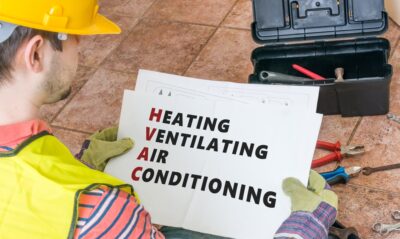Blog
21 HVAC System Terms to Know Before You Buy
3 Common HVAC System Types
1. Ductless Mini-Split System:
As the name implies, these HVAC systems do not require ductwork. Instead, units are installed in each room for greater individual control. Not surprisingly, this option can get expensive.
2. Packaged System:
This is an all-in-one unit with heating, ventilation, and cooling components within a single housing. Packaged systems are highly efficient and work better in small spaces and warmer climates.
3. Split System:
The most common type of HVAC system, a Split System, has a unit dedicated to heating and another to cooling. The AC components are typically outdoors, with the heating elements inside the building.
10 Common Heating and Cooling Terms
1. Air Conditioner:
Commercial and residential air conditioners (cooling systems) regulate indoor comfort levels by pulling heat from inside and forcing it outdoors.
2. Air Ducts:
Often located in the ceiling, behind walls, or in attics, air ducts are tubing or pipes that distribute warm or cool air throughout your property, depending on your comfort needs.
3. Condenser Coil:
Usually installed outside, the condenser coil or compressor cools your home by releasing heat from inside into the outdoor air. It compresses and condenses refrigerant as a fan blows air over the liquid, cooling it before sending it to the evaporator coil.
4. Dampers:
Dampers work to regulate airflow through the building. They are usually located on ceilings or floors. Some are motorized; others are manually operated.
5. Ductwork:
Ductwork is an integrated system of air ducts and dampers that carry cooled or heated air into your home.
6. Evaporator Coil:
Evaporator coils are responsible for cooling indoor air. Refrigerant moves through the coil, cooling the surrounding warm air. Chilled air is then forced through the ductwork into your home.
7. Heat Pump:
Heat pumps provide heating and cooling by drawing in outside air to achieve ideal temperatures.
8. Indoor Air Quality:
Indoor air quality (IAQ) refers to pollution levels inside your home or office. Foreign contaminants, pollen and other allergens, mold, and mildew produce indoor pollution.
9. Seasonal Maintenance Checkup:
Routine maintenance service, typically undertaken once in the spring and once in the fall, will extend the life of your system, lower your energy bills, and catch problems before they become costly repairs. Scheduled HVAC maintenance checkups include:
- Changing batteries, as needed
- Checking electrical system connections
- Checking for leaks
- Checking gas pressure
- Checking that assembly is in order
- Cleaning coils and condensers
- Clearing clogs or drain problems
- Ensuring all parts are in good working order
- Inspecting blowers for airflow
- Inspecting ducts for dust, mold, and debris
- Inspecting heating elements or the heat exchanger
- Lubricating moving parts, such as bearings and motors
- Replacing filters
- Replacing worn parts
10. Thermostat:
Thermostats are responsible for controlling the temperature of your indoor spaces. They work with your HVAC system and are available in manual, programmable, and “smart” models.
4 Heating/Cooling Efficiency Ratings
1. AFUE:
Furnaces are rated according to their Annual Fuel Utilization Efficiency (AFUE) ratio. AFUE measures a furnace’s capability of transforming heat into energy. The most energy-efficient furnaces have the highest AFUE percentages.
2. EER:
Used by HVAC contractors and manufacturers, the Energy Efficiency Ratio (EER) measures the overall energy efficiency of an air conditioning unit or heat pump at a 100% cooling load, 50% humidity level, and temperature between 80F and 95F.
3. HSPF:
The Heating Seasonal Performance Factor (HSPF) rating system gauges a heat pump’s efficiency level.
4. SEER:
Based on the average summertime cooling output, the Seasonal Energy Efficiency Ratio (SEER) measures heating and cooling energy efficiency levels.
4 Primary Furnace Components
Furnaces were created to warm air and distribute it throughout ductwork to achieve the desired indoor temperature. Whether designed for home or commercial use, all furnaces have four primary components::
1. Burners:
The burner, also called a combustion chamber, burns and disperses the fuel used to create warm air.
2. Heat Exchanger:
The heat exchanger converts cold air to warm air by absorbing heat, heating cold air, and providing heated air to the blower.
3. Blower:
The blower pushes the heated air through the HVAC ductwork to vents serving the various rooms of your home or office.
4. Exhaust Flue:
The exhaust flue captures and discards unwanted byproducts of the above processes.
Additional furnace components vary somewhat based on furnace type and other factors.
Serving the Denver Metro Area for Over 20 Years
In the market for a new HVAC system? Indoor Air Quality, Inc. has served Highlands Ranch and the Denver Metro Area since 2001. We proudly offer high-quality Rheem furnaces. Check out our customer testimonials, then contact us for more information and a free quote.





